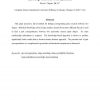Free Online Productivity Tools
i2Speak
i2Symbol
i2OCR
iTex2Img
iWeb2Print
iWeb2Shot
i2Type
iPdf2Split
iPdf2Merge
i2Bopomofo
i2Arabic
i2Style
i2Image
i2PDF
iLatex2Rtf
Sci2ools
81
Voted
PR
2007
2007
Knowledge-based part correspondence
This paper presents a direct method for finding corresponding pairs of parts between two shapes. Statistical knowledge about a large number of parts from many different objects is used to find a part correspondence between two previously unseen input shapes. No class membership information is required. The knowledge-based approach is shown to produce significantly better results than a classical metric distance approach. The potential role of part correspondence as a complement to geometric and structural comparisons is discussed.
Related Content
| Added | 27 Dec 2010 |
| Updated | 27 Dec 2010 |
| Type | Journal |
| Year | 2007 |
| Where | PR |
| Authors | Boaz J. Super |
Comments (0)

